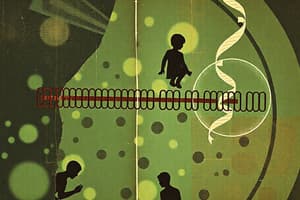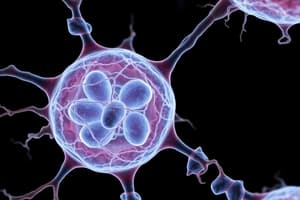Podcast
Questions and Answers
Name the proteins that DNA wraps around to form a chromosome in eukaryotic cells.
Name the proteins that DNA wraps around to form a chromosome in eukaryotic cells.
Histones
How do the structure and location of a prokaryotic chromosome differ from that of a eukaryotic chromosome?
How do the structure and location of a prokaryotic chromosome differ from that of a eukaryotic chromosome?
A prokaryotic chromosome consists of a circular DNA molecule. Eukaryotic chromosomes are rod-shaped, associated with histone and nonhistone proteins, and found within the cell's nucleus.
Does chromosome number indicate whether an organism is a plant or an animal? Explain.
Does chromosome number indicate whether an organism is a plant or an animal? Explain.
No, chromosome number does not indicate whether an organism is a plant or an animal.
Contrast sex chromosomes with autosomes.
Contrast sex chromosomes with autosomes.
Using Table 8-1, list the haploid and diploid number of chromosomes for each organism.
Using Table 8-1, list the haploid and diploid number of chromosomes for each organism.
Is there a correlation between the number of chromosomes and the complexity of an organism? Give support for your answer.
Is there a correlation between the number of chromosomes and the complexity of an organism? Give support for your answer.
What would be the consequence for future generations of cells if sperm and egg cells were normally diploid?
What would be the consequence for future generations of cells if sperm and egg cells were normally diploid?
What is the sex of the person whose chromosomes are shown in Figure 8-3 above? Explain your answer.
What is the sex of the person whose chromosomes are shown in Figure 8-3 above? Explain your answer.
Name the process by which prokaryotic cells divide.
Name the process by which prokaryotic cells divide.
What is the name of the process by which the cell's cytoplasm divides?
What is the name of the process by which the cell's cytoplasm divides?
During which of the phases of interphase does an offspring cell grow to mature size?
During which of the phases of interphase does an offspring cell grow to mature size?
During which phase of mitosis do chromatids separate to become chromosomes?
During which phase of mitosis do chromatids separate to become chromosomes?
Explain the main difference between cytokinesis in animal cells and cytokinesis in plant cells.
Explain the main difference between cytokinesis in animal cells and cytokinesis in plant cells.
Which type of molecule controls the cell cycle?
Which type of molecule controls the cell cycle?
What would happen if cytokinesis took place before mitosis?
What would happen if cytokinesis took place before mitosis?
What would result if chromosomes did not replicate during interphase?
What would result if chromosomes did not replicate during interphase?
Why are individual chromosomes more difficult to see during interphase than during mitosis?
Why are individual chromosomes more difficult to see during interphase than during mitosis?
How do the end products of meiosis differ from the end products of mitosis?
How do the end products of meiosis differ from the end products of mitosis?
How does anaphase I in meiosis differ from anaphase in mitosis?
How does anaphase I in meiosis differ from anaphase in mitosis?
Explain the role of crossing-over in ensuring genetic variation.
Explain the role of crossing-over in ensuring genetic variation.
During which stage of meiosis is the diploid number of chromosomes reduced to the haploid number?
During which stage of meiosis is the diploid number of chromosomes reduced to the haploid number?
Describe the differences between spermatogenesis and oogenesis.
Describe the differences between spermatogenesis and oogenesis.
Why is meiosis essential to sexual reproduction?
Why is meiosis essential to sexual reproduction?
Explain why the chromosomes in the haploid cells produced by meiosis I look different from those produced by meiosis II.
Explain why the chromosomes in the haploid cells produced by meiosis I look different from those produced by meiosis II.
Explain how it might happen that a human offspring with 47 chromosomes could be produced.
Explain how it might happen that a human offspring with 47 chromosomes could be produced.
In humans, the egg is larger than the sperm. Explain how it is possible that a child inherits equally from its mother and father.
In humans, the egg is larger than the sperm. Explain how it is possible that a child inherits equally from its mother and father.
Flashcards are hidden until you start studying
Study Notes
Chromosomal Structure and Differences
- DNA in eukaryotic cells wraps around histones to form chromosomes.
- Prokaryotic chromosomes are circular and lack histone association; eukaryotic chromosomes are rod-shaped and located in the nucleus.
Chromosome Number and Organism Complexity
- Chromosome count does not determine whether an organism is a plant or animal (e.g., potatoes, plums, and chimpanzees share the same chromosome number).
- There is no correlation between chromosome number and organism complexity; simpler organisms can have more chromosomes.
Gamete Structure and Division
- Sperm and egg cells must be haploid; if diploid, chromosome numbers would double each generation.
- Binary fission is the process by which prokaryotic cells divide.
Mitosis and Cytokinesis
- Cytokinesis, the cytoplasmic division, follows mitosis and differs between cell types; animal cells use a cleavage furrow while plant cells form a cell plate.
- Anaphase is the phase in mitosis when chromatids separate into individual chromosomes.
Interphase and Cellular Growth
- G1 phase of interphase is where most cellular growth occurs; chromosomes are less visible during interphase due to coiling.
Meiosis vs. Mitosis
- Meiosis results in four haploid cells, while mitosis produces two diploid cells.
- Anaphase I separates homologous chromosome pairs, while mitosis separates sister chromatids.
Genetic Variation and Reproduction
- Crossing-over during meiosis introduces genetic variation by exchanging genetic material between homologous chromosomes.
- Meiosis is crucial for sexual reproduction, ensuring correct chromosome numbers in gametes and genetic diversity in offspring.
Oogenesis vs. Spermatogenesis
- Spermatogenesis results in four equal sperm cells; oogenesis yields one egg and three polar bodies that degenerate.
Chromosome Differences in Meiosis
- Chromosomes appear different after meiosis I (sister chromatids paired) compared to meiosis II (individual chromosomes).
Genetic Contributions from Parents
- A human with 47 chromosomes could arise if a gamete with an abnormal number (24) fertilizes one with the normal count (23).
- Despite the egg's larger size due to cytoplasm, inheritance is primarily determined by DNA content from both parents.
Studying That Suits You
Use AI to generate personalized quizzes and flashcards to suit your learning preferences.




